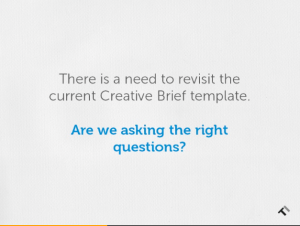
Lately, I have read a number of articles about the sorry state of the creative brief in the post digital age.
In one particular online post, I came across this list of reasons why the creative brief may no longer be an effective tool:
“1. The world has gotten faster
2. Technology has fundamentally transformed communication
3. Breakthrough matters more than anything
4. Conversations are often a brand goal
5. Powerful insights aren’t always easy to find
6. Creatives often don’t want to have the most pointed and sharpest brief
7. The internet has empowered every creative to challenge the brief and perhaps even come up with a better one on their own
8. Communication has now fragmented to such a point—how can there be one brief for everything?
9. No one reads anything anymore” (The Creative Brief project, influxinsights.com)
On another blog, I saw this slide:
And on still another blog, I saw this slide:
Are they kidding? Would someone please tell me the difference between asking new questions and creating a new template?
Better still, would someone please tell these folks that it’s not the questions, it’s the answers? And that this fundamental requirement has never, ever changed?
I get that the creative brief is, and must remain, an organic document that evolves as the nature of projects change.
But let’s also understand that no matter how brilliant the questions are, the answers have to be equally brilliant, even more so. They have to be focused, relevant, insightful. And if you don’t have insights, there are ways around that, tools that you can employ to help you divine insights from common sense and experience (see specifically the chapter that discusses the Deep Target Dive in my book How To Write An Inspired Creative Brief).
The best creative talents on the planet, from architects Frank Gehry and David Rockwell to advertising creatives like John Jay and John Boiler to authors such as Maira Kalman universally agree that the best briefs present, in the words of John Boiler, “…the most audacious and seemingly the impossible” (Briefly, Basset & Partners).
An excellent test of the well written brief, and they do exist, can be summarized by Howard Margulies:
It’s been suggested that you’ll know you’re onto something big when you can pitch the story in under 30 seconds. Can you deliver an elevator speech for your product? Are you writing it to be read?
Is this truly about new templates or better questions? Perhaps, but I think the key remains content. Whether you’re trying to break through the clutter or trying to engage your ideal buyer in a brand conversation, you still need insights to start the process. That means you need the intrepid brief writer who takes the time, in collaboration with creatives, to uncover those insights.
The result will be a brief that inspires. An inspirational brief doesn’t have to be as good as the creative it inspires. But it has to be good enough to get the creative team thinking…and doodling.
Ah, doodling and writing. Two more indicators that your brief has done its job.



